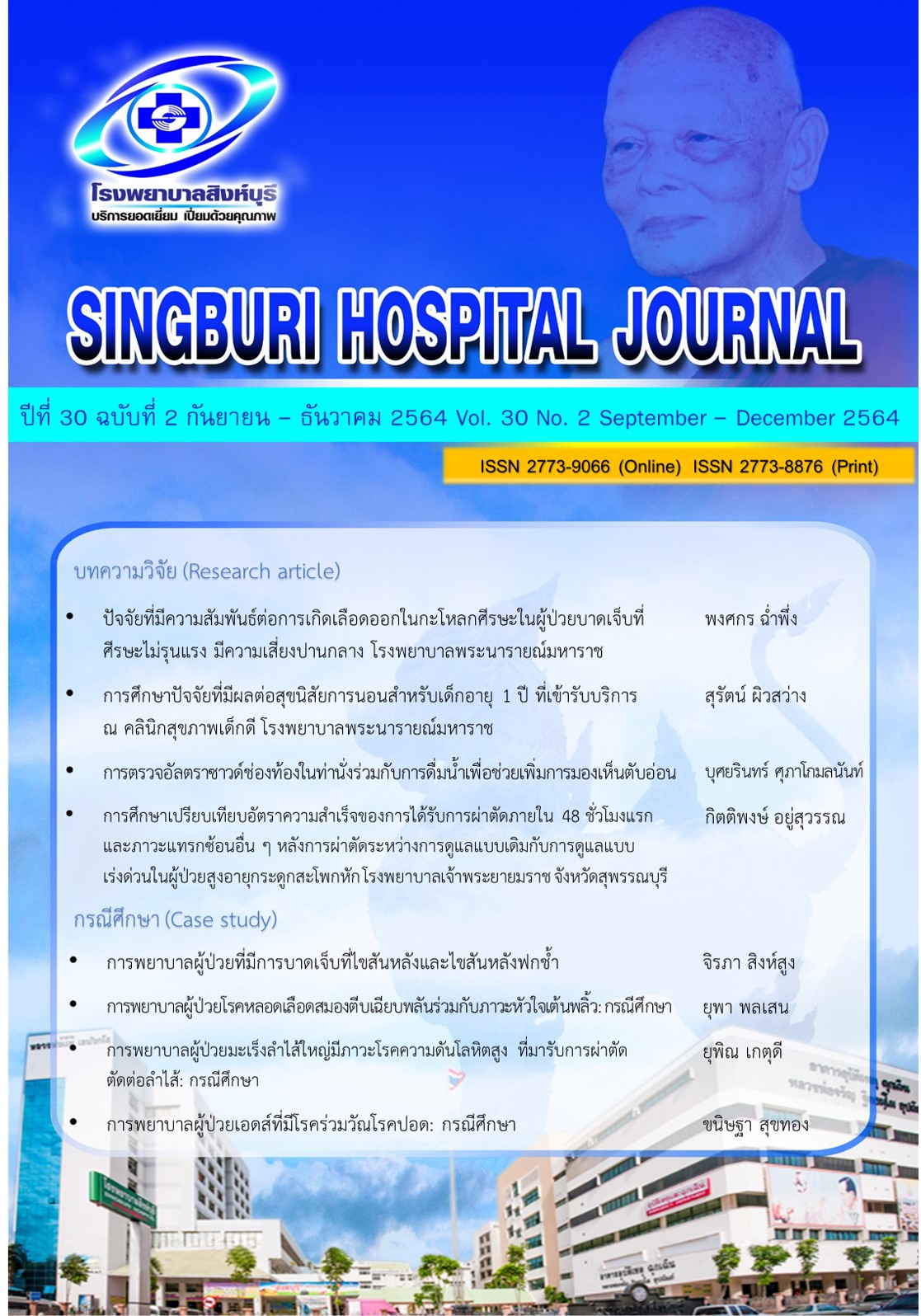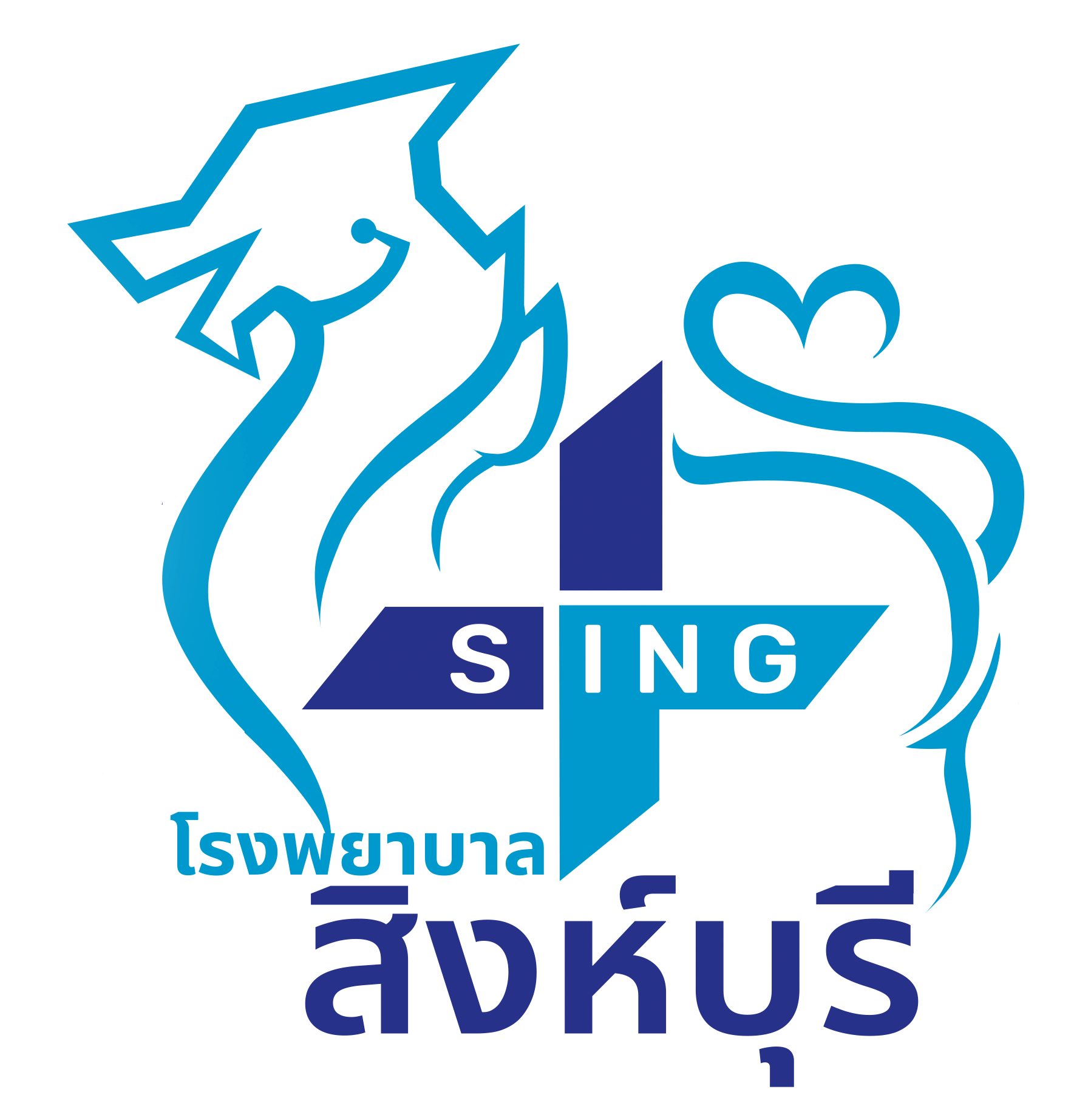การตรวจอัลตราซาวด์ช่องท้องในท่านั่งร่วมกับการดื่มน้ำเพื่อช่วยเพิ่มการมองเห็นตับอ่อน
คำสำคัญ:
ตับอ่อน ท่านั่ง อัลตราซาวด์บทคัดย่อ
บทคัดย่อ
วัตถุประสงค์ : การอัลตราซาวด์ช่องท้องสามารถตรวจหาความผิดปกติได้หลายอวัยวะ โดยมักพบว่ามีข้อจำกัดในการตรวจตับอ่อน โดยแก๊สในกระเพาะอาหารและลำไส้เล็กบดบังตับอ่อนหรือทำให้ตรวจพบตับอ่อนไม่สมบูรณ์ มีข้อแนะนำให้ผู้รับการตรวจอัลตราซาวด์ดื่มน้ำและการทำอัลตราซาวด์ในท่านั่งเพื่อเปลี่ยนตำแหน่งของแก๊สในทางเดินอาหารและให้น้ำไปแทนที่แก๊ส แต่สำหรับในประเทศไทยยังไม่พบการศึกษาอย่างแพร่หลาย
วิธีการศึกษา : การศึกษาไปข้างหน้า โดยคัดเลือกผู้ที่มารับการตรวจอัลตราซาวด์ช่องท้องในช่วงกรกฎาคม-กันยายน 2564 จำนวนรวม 236 คน หลังจากทำการอัลตราซาวด์ตามมาตรฐานในท่านอนหงายแล้วจึงให้ผู้รับการตรวจนั่งบนเตียงตรวจร่วมกับดื่มน้ำเปล่า 300 มิลลิลิตร และทำการอัลตราซาวด์ช่องท้องเพื่อดูลักษณะตับอ่อนอีกครั้ง เก็บข้อมูลพื้นฐานได้แก่ อายุ เพศ น้ำหนัก ส่วนสูง คำนวณดัชนีมวลกาย ข้อมูลที่ได้นำมาแจกแจงค่าความถี่ ร้อยละ ค่าเฉลี่ย ส่วนเบี่ยงเบนมาตรฐาน และใช้สถิติ Paired sample t-test เพื่อเปรียบเทียบค่าเฉลี่ยการมองเห็นตับอ่อนจากอัลตราซาวด์ช่องท้องก่อนและหลังการดื่มน้ำในท่านั่ง ทั้งในกลุ่มผู้มารับการตรวจทั้งหมดและกลุ่มผู้ที่มีน้ำหนักเกินและภาวะอ้วน
ผลการศึกษา : ค่าเฉลี่ยแบบวัดประสิทธิภาพการมองเห็นตับอ่อนจากการอัลตราซาวด์ช่องท้องในท่านั่งร่วมกับการดื่มน้ำ และในท่านอนตามมาตรฐาน คิดเป็น 2.61±0.56 และ 1.52±0.83 ตามลำดับ มากกว่าอย่างมีนัยสำคัญทางสถิติ (p=.000) กลุ่มผู้รับการตรวจอัลตราซาวด์ที่มีดัชนีมวลกายสูงเข้าเกณฑ์น้ำหนักเกินและภาวะอ้วน พบว่าประสิทธิภาพการมองเห็นตับอ่อนดีขึ้นในท่านั่งร่วมกับการดื่มน้ำ โดยมีค่าเฉลี่ยแบบการวัดประสิทธิภาพการมองเห็นตับอ่อนจากการอัลตราซาวด์ช่องท้องในท่านั่งร่วมกับการดื่มน้ำ และในท่านอนตามมาตรฐาน คิดเป็น 2.45±0.60 และ 1.26±0.78 ตามลำดับ มากกว่าอย่างมีนัยสำคัญทางสถิติ (p=.000)
สรุป : การอัลตราซาวด์ช่องท้องในท่านั่งร่วมกับการดื่มน้ำช่วยเพิ่มประสิทธิภาพการมองเห็นตับอ่อน เปรียบเทียบกับการอัลตราซาวด์ช่องท้องในท่านอนตามมาตรฐาน
Downloads
เอกสารอ้างอิง
1. Crade M, Taylor KJ.W., Rosenfield AT. Water distention of the gut in the evaluation of the pancreas by ultrasound. Am J Roentgenol 1978; 131:348-49. Available from: https://www.ajronline.org/doi/pdf/10.2214/ajr.131.2.348
2. Marsico M, Gabbani T, Casser T, Biagini MR. Factors predictive of improved abdominal ultrasound visualization after oral administration of simethicone. Ultrasound in Med. & Biol 2016;42:2532-37. Available from https: //core.ac.uk/ download/pdf/ 301577087.pdf
3. Ashida R, Tanaka S, Yamanaka H, Okagaki S, Nakao K, Fukuda J, et al. The role of transabdominal ultrasound in the diagnosis of early stage pancreatic cancer: Review and single-center experience. Diagnostics 2019;9(1). Doi: 10.3390/diagnostics9010002
4. MacMahon H, Bowie JD, Beezhold C. Erect scanning of pancreas using a gastric window.AJR 1979:132:587-91. Available from: https://www.ajronline.org/doi/pdf/ 10.2214/ajr.132.4.587
5. Orth OD. Sonography of the pancreatic head aided by water and glucagon. RadioGraphics 1987;7(1): 85-100. Available from: https://pubs.rsna.org/doi/pdf/10.1148 /radiographics. 7.1.3329359
6. Radiologykey. Pancreas[internet] 2016[cited2019 May29]. Available from: https://radiologykey.com/pancreas-16/
7. Okaniwa S. How dose ultrasound manage pancreatic disease?Ultrasound findings and scanning maneuvers. Gut Liver 20219; 14(1): 37-46. Doi: 10.5009/gnl18567
8. Jabar AA, Abbas I, Mishah N, Wazan M, Tomehy M. Effect of adding a capsule with activated charcoal to abdominal ultrasound preparation on image quality. J Ultrason 2020; 20(80): e12-e17. Doi: 10.15557/JoU.2020.0003
9. Madrid AM, Cumsille F, Defilippi C. Altered small bowel motility in patients with liver cirrhosis depends on severity of liver disease. Dig Dis Sci 1997;42:738-42.
10. Tosetti C, Corinaldesi R, Stanghellini V, Pasquali R, Corbelli C, Zoccoli G, et al. Gastric emptying of solids in morbid obesity. Int J Obes Relat Metab Disord 1996;20:200-5.
11. Pimentel M, Chow EJ, Lin HC. Normalization of lactulose breath testing correlates with symptom improvement in irritable bowel syndrome: A double-blind, randomized, placebo-controlled study. Am J Gastroenterol 2003;98:412-9.
12. Posserud I, Stotzer PO, Bjornsson ES, Abrahamsson H, Simren M. Small intestinal bacterial overgrowth in patients with irritable bowel syndrome. Gut 2007; 56:802-8.
13. Di Stefano M, Miceli E, Missanelli A, Mazzocchi S, Corazza GR. Absorbable vs. non-absorbable antibiotics in the treatment of small intestine bacterial overgrowth in patients with blind-loop syndrome. Aliment Pharmacol Ther 2005; 21: 985-92.
14. Skar V, Skar AG, Osnes M. The duodenal bacterial flora in the region of papilla of Vater in patients with and without duodenal diverticula. Scand J Gastroenterol 1989;24:649-56.
15. Vantrappen G, Janssens J, Hellemans J, Ghoos Y. The interdigestive motor complex of normal subjects and patients with bacterial overgrowth of the small intestine. J Clin Invest 1997; 59:1158-66.
ดาวน์โหลด
เผยแพร่แล้ว
รูปแบบการอ้างอิง
ฉบับ
ประเภทบทความ
สัญญาอนุญาต
ลิขสิทธิ์ (c) 2021 โรงพยาบาลสิงห์บุรี

อนุญาตภายใต้เงื่อนไข Creative Commons Attribution-NonCommercial-NoDerivatives 4.0 International License.
บทความที่ได้รับการตีพิมพ์เป็นลิขสิทธิ์ของโรงพยาบาลสิงห์บุรี
ข้อความที่ปรากฏในบทความแต่ละเรื่องในวารสารวิชาการเล่มนี้เป็นความคิดเห็นส่วนตัวของผู้เขียนแต่ละท่านไม่เกี่ยวข้องกับโรงพยาบาลสิงห์บุรี และบุคคลากรท่านอื่นๆในโรงพยาบาลฯ แต่อย่างใด ความรับผิดชอบองค์ประกอบทั้งหมดของบทความแต่ละเรื่องเป็นของผู้เขียนแต่ละท่าน หากมีความผิดพลาดใดๆ ผู้เขียนแต่ละท่านจะรับผิดชอบบทความของตนเองแต่ผู้เดียว







